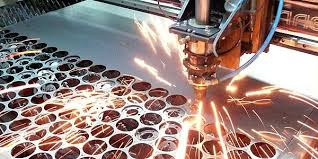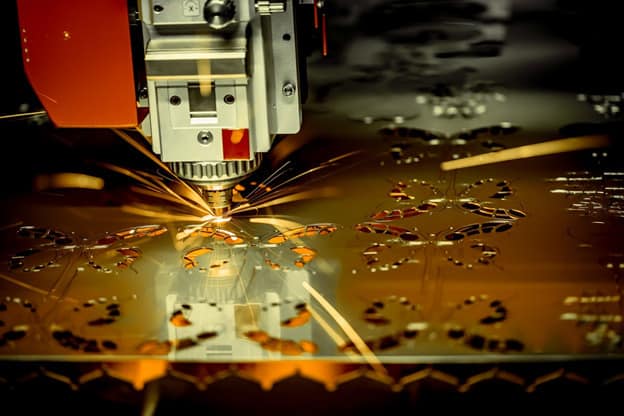Laser Metal Cutting
Laser cutting of metal is one of the most high-tech, precise, waste-free options for cutting metal blanks, which allows you to reduce the amount of waste to a minimum, speed up the process of processing metal products and obtain high-quality products.
Laser cutting of metal is a relatively new method of metal processing, as it appeared at the end of the 19th century.
Historical dates
- In 1916, Albert Einstein revealed to the world his concept of forced radiation, which became the starting point in the creation of modern laser machines.
- In 1960, Bell Laboratories researchers introduced the world’s first gas laser based on a mixture of helium and neon, which is used to this day in optics and laboratories during experiments.
- In 1963, Zh. Alfiorov and G. Kremer (Nobel Prize in Physics, 2000) developed the theory of semiconductor hetero structures, on the basis of which many lasers were created.
The principle of laser metal cutting
The principle of laser metal cutting is that the computer directs powerful laser radiation to a minimal area of metal. Under the influence of the laser, the metal melts, after which it either evaporates or is blown out with a gas jet. Thanks to this, the cut of the metal is extremely precise, there are no chips, “torn” places and other damages that require additional processing.
What types of laser cutting are used for sheet metal?
Today, most industrial sheet metal laser cutting is done using two types of lasers: CO2 and fiber.
CO2 laser metal cutting

In a gas combination that is mostly composed of carbon dioxide (CO2), helium, and nitrogen, a CO2 laser (carbon dioxide laser) is produced. An electric discharge is used to electrically pump such a laser.
The wavelength that CO2 lasers generally emit is 10.6 microns. Beams with a high kilo wattage can be produced by those employed for material processing. About 10% is the wall outlet efficiency of CO2 lasers, which is greater than the majority of solid-state tube-pumped lasers but lower than the majority of diode-pumped lasers.
A CO2 laser can cut materials thicker (>5 mm) more quickly than a fiber laser of the same power. When cutting thicker materials, it also offers a smoother surface.
In the past, CO2 lasers were used to cut sheet metal using lasers. The majority of CO2 laser cutting devices have three axes (X-Y, two-dimensional positioning control with Z-axis height control).
Moving the workpiece, the laser head, or a combination of both are all options for achieving X-Y movement.
The most often used method is referred to as the “flying optics” system, in which the workpiece is kept still while the mirrors move along the X and Y axes. The benefit of this method is that the motors move with a known constant mass at all times. It is frequently more difficult than the stock, but it is also simpler to forecast and manage.
This also implies that there is no actual sheet weight restriction because the workpiece is not changed. Flying optics’ main drawback is a change in beam size, since laser beams are never precisely parallel; rather, they diverge just a little bit as they leave the laser.
Because the size of the rough beam can vary, there may be some fluctuation in cutting performance across various areas of the table without misalignment correction. Special optics may be added to lessen this impact, and some systems even include adaptive mirror control.
An alternative is a “fixed optics” system, in which the workpiece moves in both the X and Y axes while the laser head stays fixed. Optically, this is the perfect state, but mechanically, especially for heavier sheets, it is worse.
A fixed optical system may be an effective choice for relatively low sheet weights, but as sheet weights rise, correct placement of the material at high speed may become difficult.
A “hybrid” system is a third choice, in which the material travels along one axis while the laser head moves along another. Even while this is frequently a benefit over fixed optics, the challenge of greater sheet weights persists.
Fiber lasers

Fiber lasers belong to the family of solid-state lasers. In solid-state lasers, the beam is generated by a solid medium. Fiber lasers, disk lasers, and Aramis lasers all belong to the same category.
The solid-state laser family includes fiber lasers. A solid medium produces the beam in solid-state lasers. The same category includes disc lasers, fiber lasers, and Aramis lasers.
A number of laser diodes produce the fiber laser beam. After then, the laser beam travels via an optical fiber and is magnified (similar to a conventional laser cavity in CO2 lasers). The amplified beam that emerges from the optical fiber is focused onto the material to be cut by a lens or concave lens after passing through a collimator. The benefits of fiber laser sources are as follows:
- Unlike a conventional CO2 resonator, a fiber laser source has no moving parts (such as fans for gas circulation) or mirrors in the light source. This is a major advantage in terms of reduced maintenance requirements and operating costs.
- Fiber lasers are several times more energy efficient than CO2 lasers of the same power.
- A fiber laser can cut thin sheets faster than a CO2 laser of the same power. This is due to better absorption of the fiber laser wavelength at the cutting edge.
- Fiber lasers are able to cut reflective materials without fear of back reflections damaging the machine. This allows you to cut copper, brass and aluminum without problems.
What metals are suitable for laser cutting:
Laser cutting makes it possible to cut ferrous and non-ferrous metals, namely:
- Black (carbon) steel
- Stainless Steel
- Brass
- Aluminum, aluminum alloys
- Copper, copper alloys
- Titanium
Laser cutting of metal – advantages and limitations
Advantages of laser cutting:
- Extremely high quality parts after laser metal cutting, the edges are clean and do not require additional cleaning.
- High accuracy of details, as the accuracy of the laser is 0.01 mm.
- It is possible to cut sheet metal into simple parts, as well as a complex shaped pattern.
- Laser metal cutting allows for a very fast way to complete an order, because loading the next job is done by replacing the file in the computer and replacing the sheet on the table.
- Non-contact – absence of surface defects.
- Suitable for almost all metals.
Limitations of laser cutting services:
Laser cutting of metal has its limitations, which mainly depends on the thickness of the metal. Usually, the maximum thickness of a metal sheet should not exceed 19 mm.
High-quality cutting is possibly provided that the sheet is smooth, clean, not damaged by corrosion.
“TD Altcon” LLC has been operating in Ukraine for more than 10 years and can offer laser cutting services at a high level and at reasonable prices.
Our capabilities:
- The size of the working surface of the table is 1500 × 3000 mm;
- The maximum sheet thickness is 16 mm;
- High-precision cutting – positioning accuracy on coordinates + 0.01 mm. This makes it possible to create complex shaped parts and minimize waste;
- The parts have a clean and smooth cut without burrs and burns;
- Possibility of laser cutting of sheet metal: black, galvanized, stainless, aluminum.
- The order is executed in the shortest possible time.
- You can make a preliminary calculation of the cost of your order on the Calculator.

